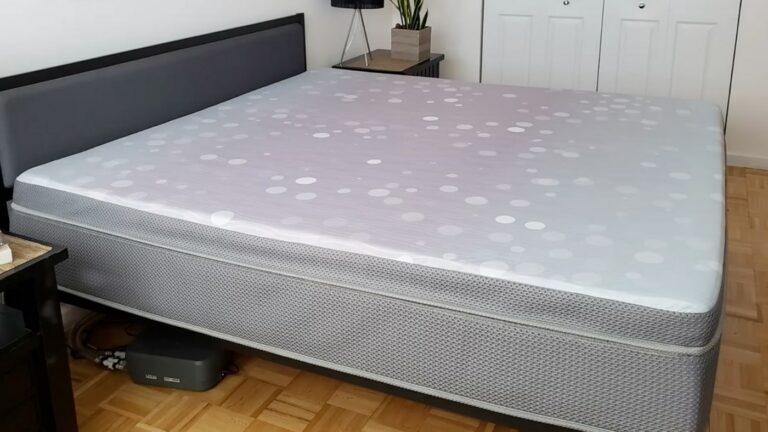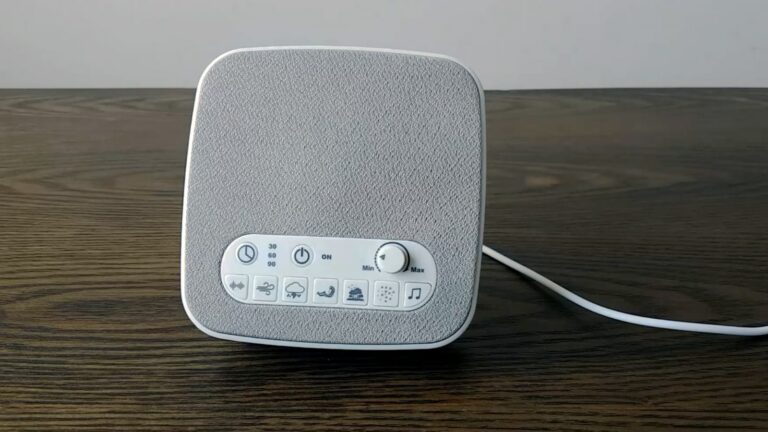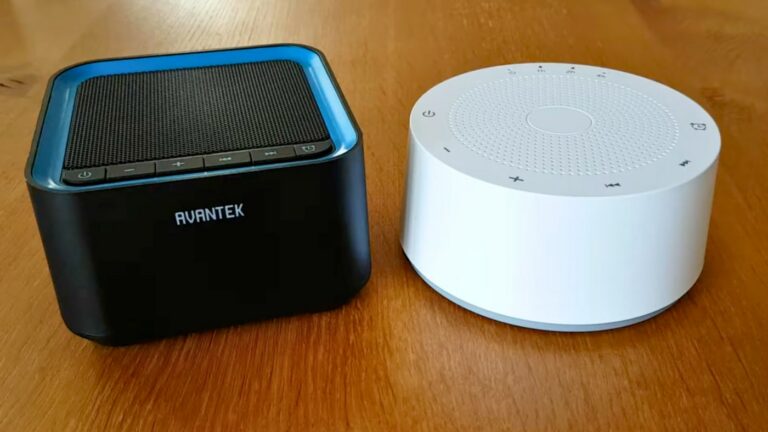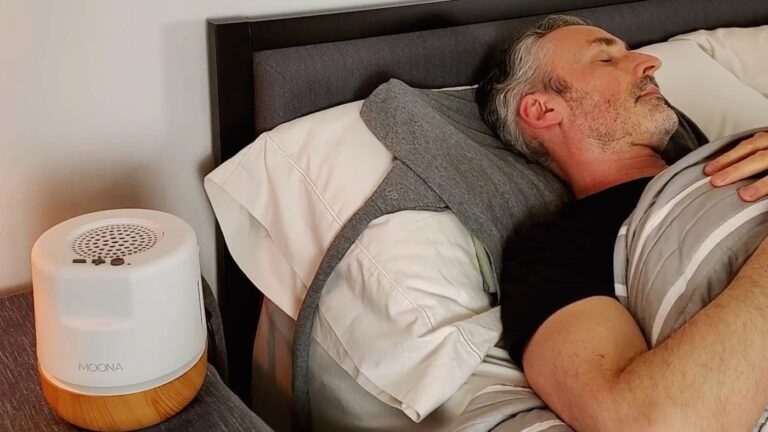Update: There is a newer version of the QuietOn earbuds. You can read my QuietOn 3.1 review here.
Full review / video transcript
I’ve made a few edits to the video transcript so it’s clearer to read. I also added some extra notes to clarify some points I made.
Introduction
Hi, I’m Ethan Green from nosleeplesnights.com, and in this video I’m going to unbox and test out the Quieton earbuds.
As I see it, these are essentially very fancy high-tech earplugs. They have active noise cancellation, but you can’t play music through them. What you can hopefully do is block out more noise, such as snoring, than you would do with traditional earplugs.
Since they cost just under $200 though, they’re going to have to really impress me to make me think that they’re better than the standard foam earplugs I’ve been using for many years, and that are cheap and effective.
In a moment I’m going to unbox them. And then I’ll test them out and use them for a few nights to see how effective and how comfortable they are. If you’re not interested in watching the whole unboxing, please skip ahead.
So with that said, let’s head over to the table and check them out.
Unboxing
In the photo below, you can see what came with the Quieton 2 when I got them: the box, carry case, earbuds, spare tips, and charging cable.
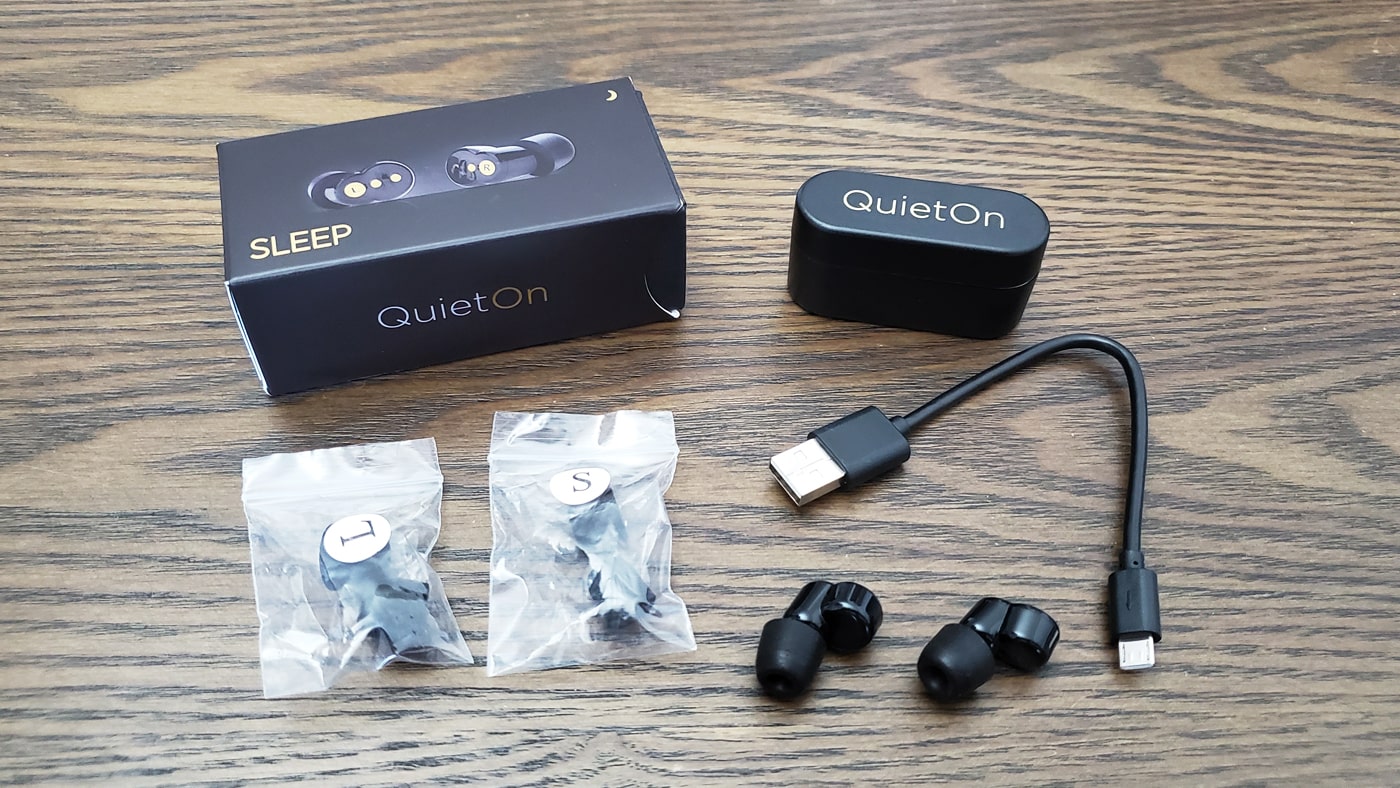
Before I actually open the box, I’d just like to say that I think first impressions do count sometimes. And so far so good. I like the way it looks – like something that would make a nice gift. But the proof of the pudding is in the eating. So let’s take a look.
Inside it says “your partner in a noisy world” (this is written on the box). Let’s hope so! Here we have a case. And what else have we got in here? What looks like different size tips – small and large. Presumably, the medium tips are already placed on the actual earbuds then.
And here we have a charging cable, which is a USB to micro USB. It’s extremely short, but I hope that’s not going to be a problem. There’s no power adapter supplied, so you need to provide that yourself. But it’s not an issue to find USB outlets in most people’s houses, I don’t think.
Here we have a user guide, which looks like it’s in English. And it looks like down there we’ve got some other languages as well, which is useful for some people (there are several languages included).
I’m not going to go through the entire user guide, because I’ve been told it’s a little bit boring when I’ve done it before! But I know some people appreciate being able to see the instructions. So I’m just going to scan through quickly so people can pause if they don’t have the instructions or they lose them.
There you go. And the other side is mostly warnings I think. So if you do lose your instructions, you can pause the video.
(The instructions appear at 1:37 in the video if you want to see them)
Now let’s have a look at the actual earbuds themselves. This case is quite heavy actually, which is quite surprising. And on the back, we have the charging port as well. I believe that you don’t actually charge up the earbuds, you charge the case that they sit inside.
Note: Just to be clear, you do charge the earbuds. You need to place them inside the case and then use the charging cable provided to plug the case into a USB outlet.
So the device itself – let’s have a look inside. Here you can see the two bits there that go from the charging port into the actual earbuds. We’ve got a sticker here, which you need to remove.
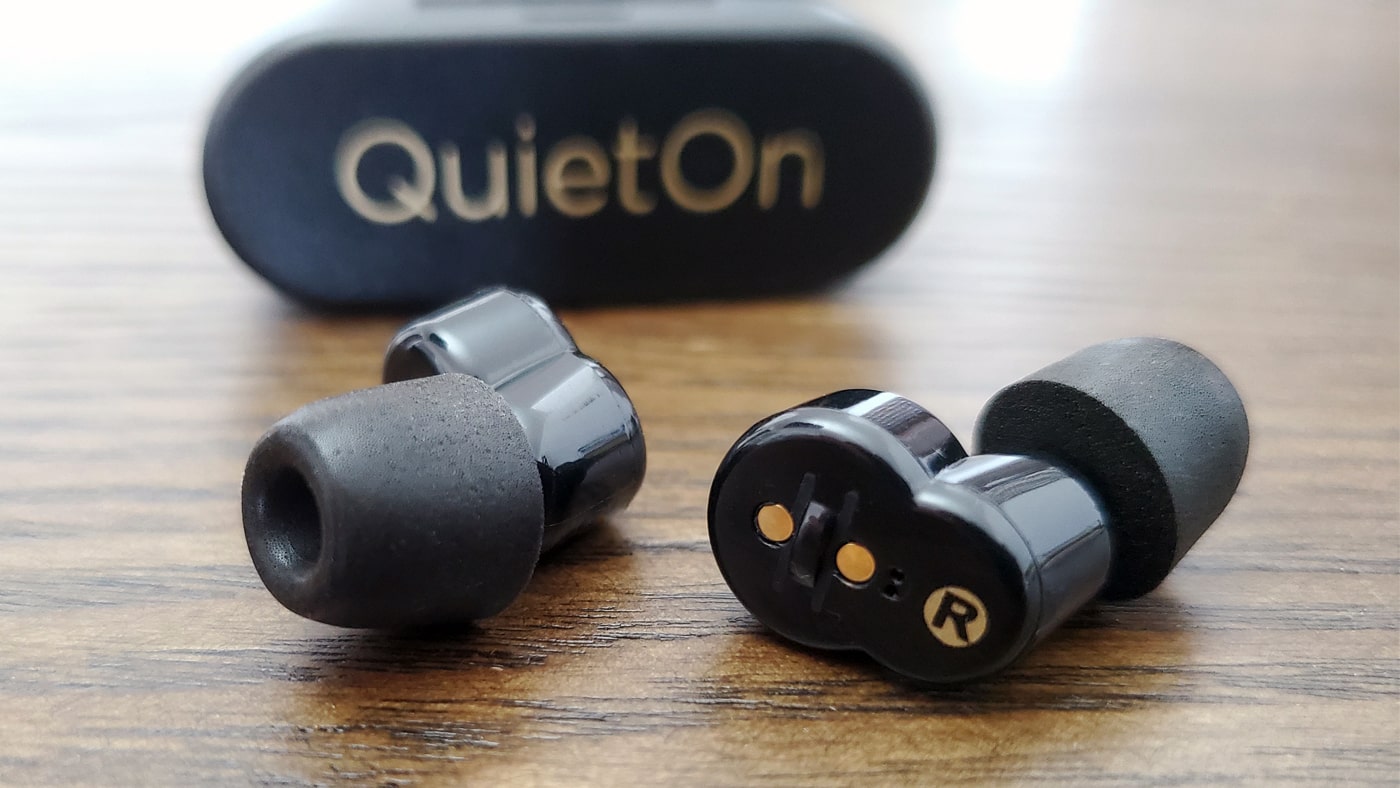
Mode button – I believe that it has a hearing and a silent mode, so you can have it with the noise cancellation or without, if you’d rather be able to hear what’s going on around you.
So, here let’s have a look at the tips. And you can see that they’re quite squidgy. I believe it’s memory foam, and I like that. Hopefully, it’s going to be able to make a nice fit in your ear, because ultimately the active noise cancellation is not going to be that much use if they don’t fit nicely inside your ear.
So really, I think there’s not much more for me to do in the actual unboxing. I think the main bit that’s going to be interesting is charging them up, which I believe takes about an hour. And then putting them in my ears and testing them out, and seeing how well they block out different sounds in my bedroom.
So that’s exactly what I’m going to do, and then I shall be back in the bedroom to tell you about them.
First thoughts after two hours testing them
Below, you can see how the Quieton 2 fits inside my ear canal.
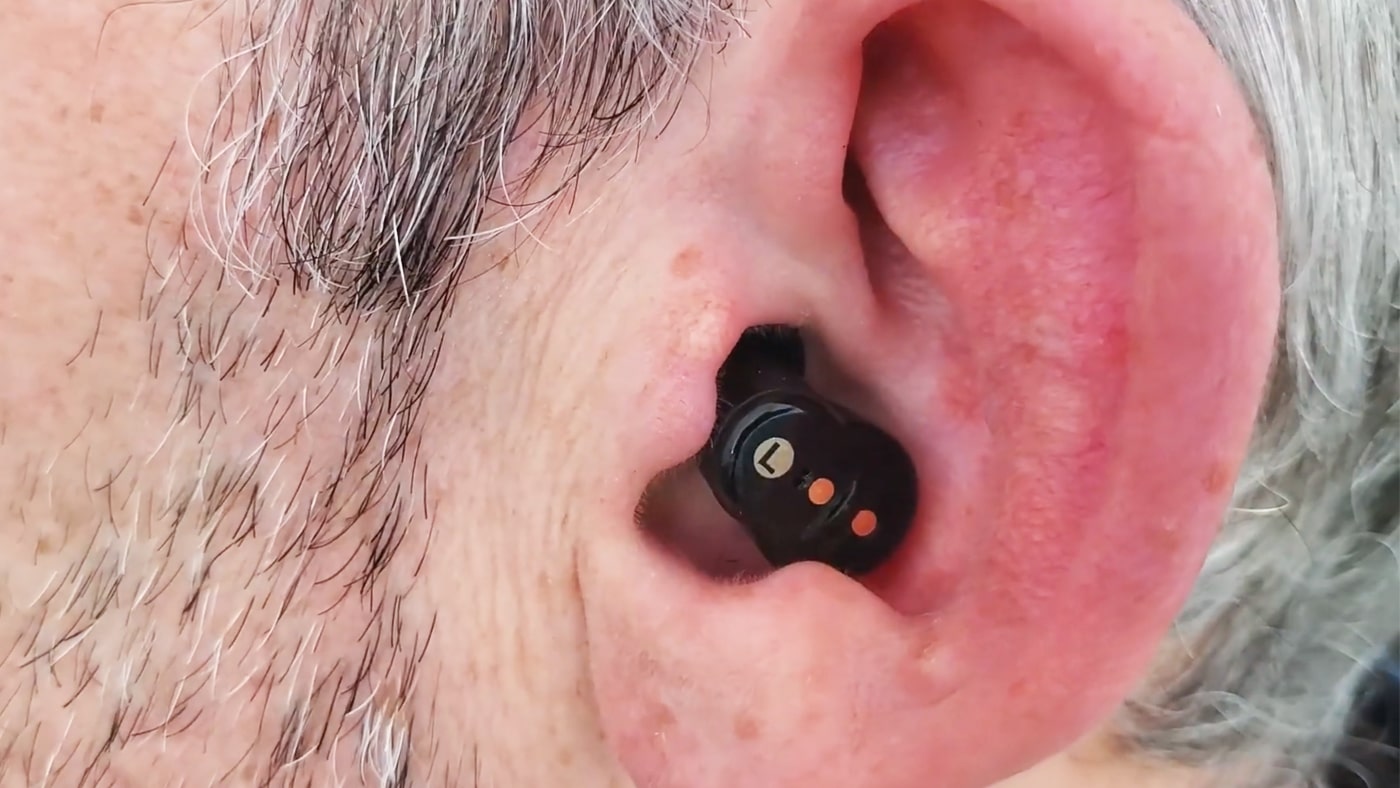
I’ve now had a chance to play around with the Quieton and test them out in the bedroom a little bit. And I’ve got to say there’s good news and there’s some bad news, at least as far as my first impressions go.
The good news is that they definitely work. I think the fact that they have that button that allows you to change between hearing mode and silent mode means that you can find out whether the technology does something, or whether it’s just having something inside your ears like earplugs that’s preventing noise.
When you do press the button, which I have to say is a little bit fiddly – finding it and then pressing it – you can hear there’s a real difference in the noise cancelling. So that’s a good thing.
And I’ve got to say, it does block out some of the ambient noise. This is actually a really good place to test noise reduction because I live in a building on the 20th floor, with an enormous amount of air conditioning units.
I don’t know how many of them are on at the moment, but I always say the sound of my neighborhood is an air conditioning unit because there are just so many of them. And I can hear it even with the windows closed, as they are now.
So when I have these on silent mode, it definitely cuts out some of that drone, which is great because that’s the noise that really annoys me in the nighttime.
I also tested it with my own air conditioning unit on in the bedroom, and it cuts out some of that noise as well, but not all of it. So as far as the actual technology is concerned, and the fact that you might be wondering whether they work or not: they do work.
Now for the bad news. First of all, as you can see, I’m lying on my side. And even though the actual tip is memory foam, there’s still this part of it here which is solid plastic. And you can feel it on your ear, even on your side.
So I think if you’re a side sleeper I’m going to have slight concerns about how comfortable they are to wear. But that’s something I’m going to find out over the next week when I continually use them. So that’s one thing to note. But lying on your back it’s not an issue at all.
Note: I didn’t fully clarify this point at the end of the video. But I think this first impression was accurate: I don’t think they are ideal for side sleepers unless you have a special pillow with a hole or indentation. But for back sleepers, they are very comfortable.
However, the main issue that I’ve found so far, at least in my initial couple of hours of testing, is that they’re no better than my foam earplugs. And that’s a real disappointment, I have to say.
One caveat is that I have discovered already that the fit that you have with them makes a massive difference. I’ve tried with the small tips and the large tips, and they definitely don’t really work at all for me. So that automatically makes me think that the fit is important: the fact that one set of tips makes a big difference.
The way that you have them angled in your ear is also important. You need to twist them backwards to get the fit right. And I’ve found that in some positions they really don’t do much at all. And then all of a sudden, playing around with it you think “okay, that’s the position.” And you realize that they’re actually doing something.
And pressing the button is something that I wouldn’t recommend doing too much, because you end up kind of pushing this plastic thing into your ear, which isn’t the most comfortable.
So those are my first thoughts. Now I’m going to try the Quieton out for the rest of the week. I’ll try and sleep with them and see what that’s like, and use them around the house as well. And I’ll try them with some different noises and then get back to you.
Thoughts after one week of testing the Quieton
I’ve now spent a few more days using the Quieton and I have to say I think my first impressions were largely accurate. However, I do think it’s worth discussing their usefulness during the day and the nighttime separately.
For the night, for me, I just can’t get past the fact that my foam earplugs did a better job. With their noise reduction rating of 33 decibels, they just blocked out more noise than the Quieton.
However, I know that some people find foam earplugs uncomfortable when they expand and put too much pressure on your ears. And I found the Quieton actually better than wax and silicone earplugs. So I can imagine that for some people the Quieton might be more suitable, but just not for me.
For me personally though, perhaps the best use of the Quieton was during the daytime, which surprised me.
I like the fact that they feel comfortable and you can easily switch between the hearing and silent mode without having to take them out and try and put them back in again, which can be tricky with warm foam earplugs.
Below, you can see the tiny button to switch between hearing and silent mode.
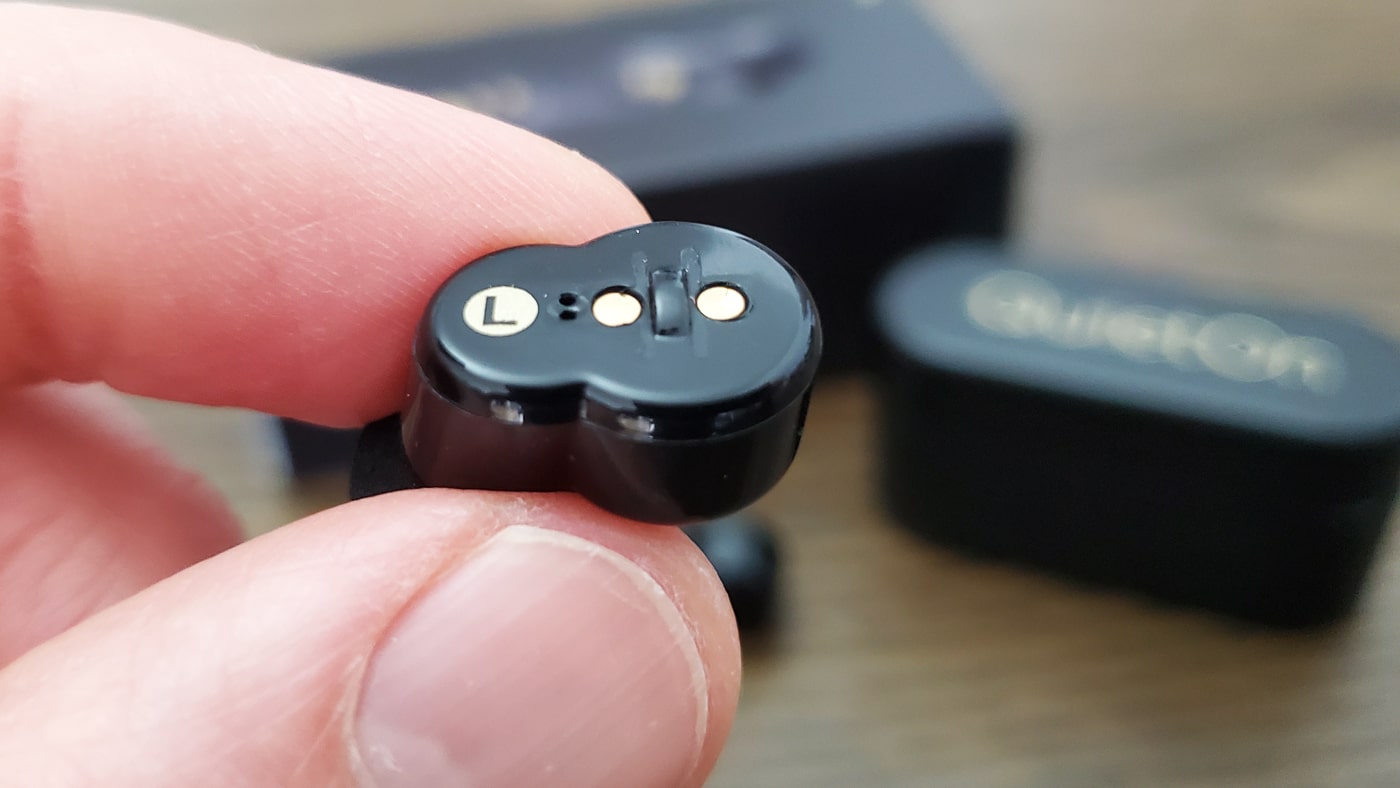
And actually, I found that the noise cancellation was just on par with my Bose Quiet Comfort 20 which, although they can play music as well, have been some of my favorites when it comes to noise cancellation. So the fact that they matched them impressed me.
Another point in their favor is that they only take an hour to charge, and they’ll last for a good 20 hours.
And I also like the fact that they’re pretty quiet you don’t really hear much of the white noise sound that you sometimes do with noise cancelling headphones.
The fact remains though that the Quieton are expensive, which might be fine if money is no object and they fix a particular problem you have with noise. However, if you’re on a budget, I don’t think I could recommend saving up for them unless you really don’t want to use normal earplugs, headphones, earbuds, or whatever it might be.
And you really like the idea of being able to switch the silent mode hearing mode, and change between them very easily without needing to take them out.
So there you go, I hope that you found this review useful. If you did and you’re interested in buying them, please use the link in the description below. And please also subscribe to my YouTube channel to keep in touch with me and see future reviews. Thanks again, this is Ethan from No Sleepless Nights.
Additional notes two weeks after my first tests
Note: this section isn’t in the video.
Since I filmed the unboxing and review, I’ve had even more time to use the Quieton, and there are a couple more points I think might be useful to consider.
Firstly, other than discussing the box, I didn’t talk about the aesthetic design of the earbuds themselves. And actually, I really like how stylish they look, as well as the case you keep them in and charge them from.
Admittedly, the aesthetic appeal isn’t very important if you’re only going to use them when sleeping! But if you plan on using them in public, such as when travelling or working, they look a lot more stylish than foam earplugs – if that’s important to you.
I also really like the way they are charged from within the case. I much prefer that to leaving them lying around on a shelf or table while charging. It feels more hygienic and less likely you’ll lose them. And importantly, I’ve found this system very convenient, and makes it more likely I’ll charge them when needed.
One new criticism I’ve discovered is that it’s not immediately obvious if they are turned on or not. They work automatically when you remove them from the case. But if you don’t get the fit right, it’s hard to know if they are on silent or listening mode. There is also no charge indicator, so you might find they stop working with no warning if you don’t regularly charge them by habit.
I’ve continued to use them during the daytime when I’m not in the mood for music, and my home is noisier than I’d like. I really love the way you can quickly switch between hearing and silent mode. I continue to think that this is a standout feature of the Quieton, and one I definitely use.
I haven’t used them when travelling yet – I’m doing this review in the middle of 2020, so there’s not much travel happening due to the pandemic. But I can imagine I would consider using them on a plane in the future.
Now, back to sleep – one of the core uses. I can’t say I’ve changed my mind on this point. I will stick to my foam earplugs or headphones for now.
But I do still think they will work well for people who hate the feeling of foam earplugs expanding in the ear. But – not if you’re a side sleeper. Presumably, someone who has sensitive ears to the point where foam earplugs are no good to them also won’t want plastic earbuds in their ears.
I think the manufacturer is correct when they say the Quieton won’t cut out all noise and are better for lower frequency noise. They are great at cutting out deeper ambient noise like my air conditioning unit or music and TV in the distance. But some noise, like the beeping of trucks reversing and sirens definitely cut through. To be fair though, I’m yet to try noise cancelling headphones or earbuds that cut out all noise – they all have limitations.
As for the age old problem of snoring, they reduce it, but like even the very best of earplugs, it very much depends on how bad the snoring is. So if your partner snores loudly right next to your ears, don’t expect miracles from the Quieton.
Final verdict
The Quieton are effective noise cancelling earbuds that could be ideal if you want to cut out noise without replacing it with more noise. If you sleep on your back, and don’t like normal earplugs, they are a comfortable and effective way to reduce some noise in bed. However, they will be less comfortable for side sleepers because of the plastic casing.
They are stylish, convenient, and effective to use during the day. It’s great that you can independently switch from hearing to silent mode in each ear so you don’t need to take them out to have a conversation. The price is a little high at around $200 though, so they are not a budget solution to noise problems.

